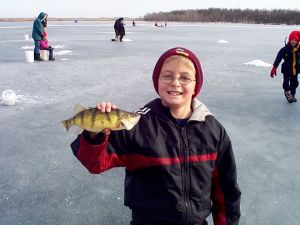Panfish Through The Ice

One of the most enjoyable aspects of winter ice-fishing is the pursuit of panfish, in particular white perch and yellow perch. Both are great eating and the yellow perch is at its best for quality during the winter months. Although these two species are both called perch, their habits and habitats are very different and call upon anglers to use different procedures to catch them. White perch are basically territorial and stay within certain areas and depths. Yellow perch are more nomadic and often follow wherever their food source brings them. They suspend off the bottom more than the white perch do.

Although friends and I20have found ice-fishing for both white and yellow perch provides great fun and often lots of action, there are times when it can be frustrating. None-the-less, it is being out on the ice fishing and enjoying the day that counts most. For the best success fishing for yellow perch, be prepared move around. The use of jigging rods with small size jigs and baited with either a small piece of cut shiner, half a night crawler or a whole meal worm works well. Tip-ups should be set at various depths, but usually not over 20 feet deep. One of the tactics we used was to cut two holes at each tip-up so that when a yellow perch hit’s the tip-up they just set the hook and we leave the perch in the water as an attractor decoy. Then, drop your jig down the other hole and if a school of yellow perch are still there, the fishing can get really hot until the school moves on. You can also just pull your tip-up caught perch out of the hole and then start jigging the same hole. Some anglers just drill holes and move around jigging the different holes. However, your chances of success are better combining tip-up usage and jigging.
White perch are much different in their habits and you will not likely get a mixed bag of white and yellow perch unless you target each species independently. The white perch are more of a bottom feeder than the yellow perch. They are more likely to stay on a muddy bottom that has a lot of insect activity. Depths for white perch=2 0are usually in the 35 to 50 foot range and they are most often caught within a foot or two of the bottom. Although white perch will hit live shiners (2 to 2 ˝ inch in length), the most effective fishing comes by using small jigs tipped with grubs, mealworms or small pieces of night crawler. When a concentration of White perch is found, pay attention to where you are since they are apt to be back in the same area the next time you are out fishing. Schools of white perch will move, but not consistently like yellow perch do. If they do move, it’s a good idea to use spread-out tip-ups to find them again.
Another good piece of equipment that can greatly help you find schools of perch is a depth-finder (often called a fish-finder). By adding a little water to the ice surface, you can scan through the ice and the unit will show a clear picture on your screen of any fish or schools of fish that are underneath. The depth-finder will also show you the depth the schools are at and this will eliminate guess work. So, dress warm and enjoy your time fishing on the ice and have fun this winter.

Bob Harris can be
reached via e-mail at:
outwriter2@aol.com
Past
Columns by Bob Harris
>>>
About
Bob Harris
>>>
DISCLAIMER: The opinions
expressed by Mr. Harris are not necessarily those of the
Goffstown Residents Association or its members
Copyright©2009 Goffstown Residents Association. All Rights Reserved. |





